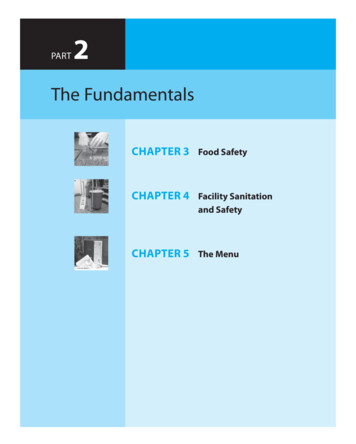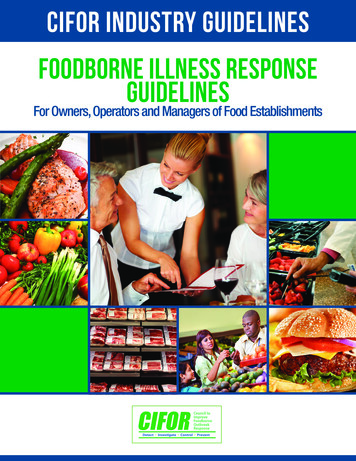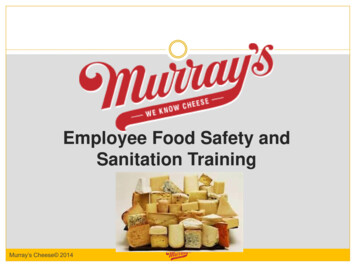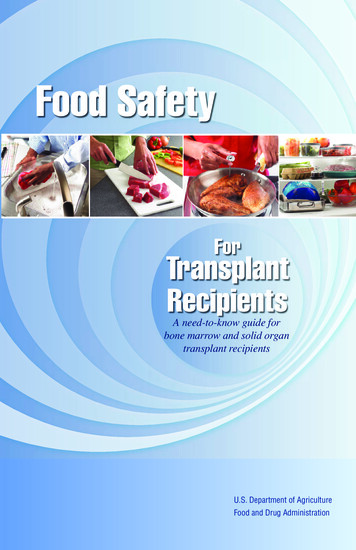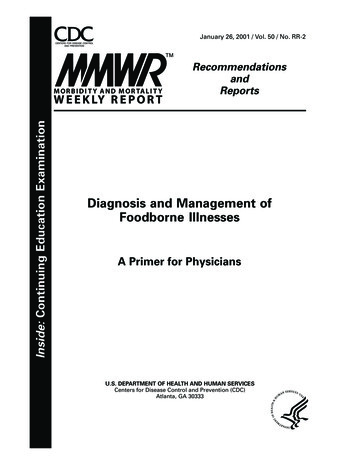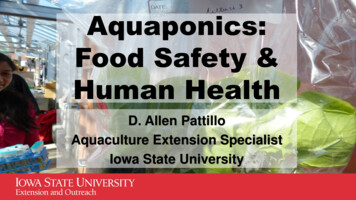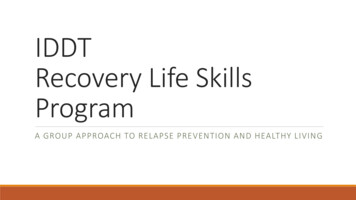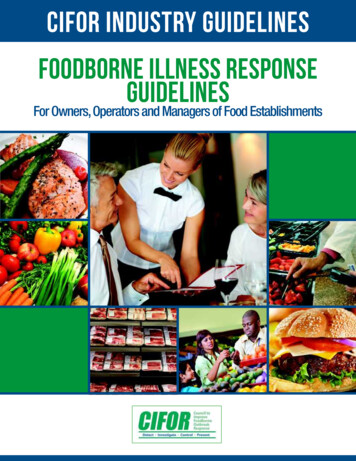
Transcription
CIFOR INDUSTRY GUIDELINESFOODBORNE ILLNESS RESPONSEGUIDELINESFor Owners, Operators and Managers of Food Establishments
DISCLAIMERDISCLAIMEREven though these Food Establishment Guidelines and the accompanying Tools provide comprehensive information for the Food Industry in preparation for, and/or involvement in, foodborne disease outbreak investigations, these documents are not intended to replace pre-existingcompany guidelines or local, state, or federal regulations or procedures. Industry should consider using the Guidelines and Tools to compare existing procedures, fill in gaps and updatesite-specific procedures, create procedures where they do not exist, and train staff.3
ACKNOWLEDGMENTSCIFOR supported the establishment of the CIFOR Industry Guidelines Workgroup to developfoodborne illness response guidelines to help industry in day-to-day operations and duringinvestigations of foodborne illness outbreaks.The CIFOR Foodborne Illness Response Guidelines for Owners, Operators, and Managers ofFood Establishments is the result of countless hours of work by the CIFOR Industry GuidelinesWorkgroup, CIFOR Council representatives, and others. The CIFOR Industry GuidelinesWorkgroup was made up of food industry representatives, consulting companies, governmentagencies, and CIFOR Council representatives (members).This document represents CIFOR’s strong commitment to assist the food industry in its effortsto take an active and educated role in the response and investigation of foodborne illnessoutbreaks. CIFOR expresses its deep gratitude to everyone who supported the development ofthese guidelines.Development of this document was supported by FDA and Cooperative Agreement #U60HM000803 and 5U38HM000449 from CDC. Printing was supported by the CDCFoundation. The contents of the document are solely the responsibility of the authors and donot necessarily represent the official views of FDA , CDC, or the CDC Foundation.4
Guidelines for Owners, Operators and Managers of Food EstablishmentsCIFOR Industry Guidelines WorkgroupApril Bogard, Environmental HealthSupervisor; Minnesota Department of HealthMary Cartagena, Consumer Safety Officer;U.S. Food and Drug AdministrationFrank Ferko, Director, Distribution FoodSafety & Quality Assurance; U.S. FoodserviceTom Foegle, Vice President, Food Safety &Quality Assurance; Windsor FoodsLisa Hainstock, Food Safety Specialist,Michigan Department of Agriculture andRural Development; (CIFOR representative forAssociation of Food and Drug Officials)Jill Hollingsworth, Senior Vice President,Food Safety Programs; Food MarketingInstituteDaryl Kellenberger, Director of Food Safety– U.S. Operations; McDonald’s CorporationKirsten Larson, Senior Specialist, FoodSafety Program; Association of Public HealthLaboratoriesChristopher T. Melchert, Senior Manager,Food Safety & Quality Assurance; NationalRestaurant AssociationTomeji Miller, Health Manager; City of PlanoHealth Department, TexasPaulo Mohyla, McDonald’s U.S. SupplyChain – Quality Systems Manager; McDonald’sCorporationACKNOWLEDGMENTSCatherine Adams Hutt, RdR SolutionsConsulting; (representing National RestaurantAssociation)George Nakamura, President, CEO;Nakamura Leasing, California, (CIFORrepresentative for National EnvironmentalHealth Association)Karen Neil, Medical Epidemiologist, Divisionof Foodborne, Waterborne and EnvironmentalDiseases; U.S. Centers for Disease Control andPreventionDavid C. Nicholas, Epidemiologist/Environmental Health Specialist Network(EHS-Net) Coordinator; New York StateDepartment of HealthRichard Parker, Quality Assurance-ScientificAffairs; H-E-B GroceryDanny Ripley, Food Inspector II; MetroPublic Health Department, Nashville/DavidsonCounty, TennesseeMary Sandford, Manager, Food Safety& Regulatory Compliance; Burger KingCorporationBecky Stevens-Grobbelaar, Director, FoodSafety and Regulatory Affairs; Yum! Brands,Inc.5
cIFOR FOODBORNE ILLNESS RESPONSECIFOR Council RepresentativesACKNOWLEDGMENTSChair: Timothy Jones, StateEpidemiologist, Tennessee Department ofHealth; CSTEChair: Joseph Russell, Health Officer,Flathead City-County Health Department,Montana; NACCHORobyn Atkinson-Dunn, Director, UtahUnified State Laboratories: Public Health;APHLRob Blake, Chief, Environmental HealthServices Branch; CDCDavid Boxrud, Molecular EpidemiologySupervisor, Minnesota Department of Health;APHLLouisa Castrodale, State Public HealthVeterinarian, Alaska Department of Health andSocial Services; NASPHVJohn Dunn, Deputy State Epidemiologist,Tennessee Department of Health; NASPHVKathy Fowler, Director, Kentucky Division ofPublic Health Protection and Safety; ASTHOLisa Hainstock, Food Safety Specialist,Michigan Department of Agriculture; AFDORoberta Hammond, CORE ResponseManager, Office of Foods and VeterinaryMedicine; FDAScott Holmes, Manager, EnvironmentalHealth Division, Lincoln Lancaster CountyHealth Department, Nebraska; NACCHOKristin Holt, USDA/FSIS Liaison to CDC,Food Safety and Inspection Service; USDASteve Ingham, Administrator, Divisionof Food Safety, Wisconsin Department ofAgriculture, Trade and Consumer Protection;NASDAErnest Julian, Chief, Office of FoodProtection, Rhode Island Department ofHealth; AFDOHeidi Kassenborg, Division Director, Dairyand Food Inspection Division, MinnesotaDepartment of Agriculture; NASDABill Keene, Senior Epidemiologist, Acuteand Communicable Disease Program, OregonPublic Health Division; CSTEMel Knight, Past President; NEHASusan Lance, FDA liaison to CDC, Office ofFoods and Veterinary Medicine; FDABela Matyas, Health Officer, Solano County,California; NACCHOGeorge Nakamura, President, CEO,Nakamura Leasing, California; NEHACarol Selman, Public Health Advisor,National Center for Environmental Health;CDCDonald Sharp, Deputy Director, Food SafetyOffice; CDCKirk Smith, Supervisor, Foodborne,Vectorborne, and Zoonotic Diseases Unit,Minnesota Department of Health; CSTERegina Tan, Director, Applied EpidemiologyStaff, Office of Public Health Science, FoodSafety and Inspection Service; USDAIan Williams, Chief, Outbreak Response andPrevention Branch; CDC6
Guidelines for Owners, Operators and Managers of Food EstablishmentsJim Blumenstock, Chief Program Officer,Public Health Practice; ASTHOJennifer Li, Director, Environmental Health;NACCHOJeffrey Engel, Executive Director; CSTELarry Marcum, Managing Director; NEHARebecca Johnson, Program Analyst;NACCHODhara Patel, Associate Research Analyst;CSTEAbraham Kulungara, Director,Environmental Health; ASTHOLauren Rosenberg, Director of Marketingand Communications; CSTEKirsten Larson, Senior Specialist, FoodSafety Program; APHLSharon Shea, Director, Food Safety Program;APHLACKNOWLEDGMENTSCIFOR Association StaffContributors and ReviewersMarion Aller, Acting Deputy Commissioner,Florida Department of Agriculture andConsumer Services; NASDAJohn Besser, Deputy Chief, Enteric DiseasesLaboratory Branch; CDCJoseph Corby, Executive Director; AFDOPatrick J. McConnon, Executive Director;CSTERandy Robertson, Director, Complianceand Investigations Division, Food Safety andInspection Service; USDAPeter Gerner-Smidt, Chief, Enteric DiseasesLaboratory Branch; CDCDoug Saunders, Deputy Director, Divisionof Animal and Food Industry Services, VirginiaDepartment of Agriculture and ConsumerServices; NASDAJohn J. Guzewich, Senior Advisor forEnvironmental Health, Center for Food Safetyand Applied Nutrition and Science; FDADavid Sweat, Foodborne DiseaseEpidemiologist, North Carolina Division ofPublic Health; ASTHORobert Hicks, Director, Office ofEnvironmental Health Services, VirginiaDepartment of Health; ASTHORobert Tauxe, Deputy Director, Division ofFoodborne, Waterborne, and EnvironmentalDiseases; CDC7
TABLE OF CONTENTSDISCLAIMER . 3ACKNOWLEDGMENTS . 4-7BACKGROUND . . 9INTRODUCTION . . 10-11OUTBREAK INVESTIGATION PREP – RECOMMENDATIONS . 12-20FOOD ESTABLISHMENT SELF-ASSESSMENT . 21-22MEDIA . 23STORE CLOSURE AND REOPENING . 24CONTROL MEASURES . 25FLOW DIAGRAM: GUIDELINES AND TOOLS . 26TERMS AND DEFINITIONS . 27-29TOOLS . 31-78Tool 1Tool 2Tool 3ATool 3BTool 4Tool 5Tool 6Tool 7ATool 7BTool 7CTool 7DTool 7ETool 7FTool 7GTool 8Tool 9Tool 10Tool 11Tool 12Tool 13Tool 148Illness Complaint Tracking Log FormCustomer Foodborne Illness Complaint FormMenu Ingredient Listing FormExample Menu Ingredient ListingEmployee Communications MeetingEmployee List FormEmployee Health Assessment FormEmployee Illness Decision GuideExample Of Employee Illness Decision Quick Guide for Person-In-Charge(For Non-HSP Establishments)Poster: My Story Could Change Your LifePoster: Do I Feel Well Today?Poster: I Should Have Stayed HomePoster: Would You Want These People in Your Kitchen?Poster: Don’t Let What Happened to Me Happen to YouProduct Sampling ProcedureSample Chain Of Custody FormDistributor And Supplier Information FormSample Food Establishment Food Safety Checklist FormFood Flow Chart FormExample Employee Workstation SchematicSample Re-Opening Self Inspection Checklist Form
BACKGROUNDIn 2009, the Council to Improve Foodborne Outbreak Response (CIFOR) developed *Guidelinesfor Foodborne Disease Outbreak Response to aid government agencies responsible forpreventing and managing foodborne disease by establishing a foundation for outbreak responseand encouraging a standardized foodborne disease investigation process across all governmentagencies.There is no standard approach utilized by public health/regulatory authorities for foodbornedisease outbreak response. No one set of steps is appropriate for all outbreaks. The responsevaries with the outbreak and surrounding circumstances (e.g., etiologic agent, number of cases,and likely source of exposure).The CIFOR Industry Guidelines outlines, clarifies, and explains the recommended role of owners,operators, and managers of food establishments in a foodborne illness outbreak investigation.The CIFOR Industry Guidelines was developed by food industry leaders and local, state, andfederal regulatory and non-regulatory public health agencies with expertise in epidemiology,environmental health, laboratory science, communications, and food industry operations andis an example of what can be achieved to promote food safety when public health and industrywork in partnership.*Council to Improve Foodborne Outbreak Response (CIFOR). Guidelines for Foodborne Disease OutbreakResponse. Atlanta: Council of State and Territorial Epidemiologists, 2009.9
INTRODUCTION TO FOOD ESTABLISHMENTRESPONSE GUIDELINESCIFOR recognizes the critical role the food industry plays in the prevention of foodbornedisease and the invaluable support they can provide during the foodborne disease investigation process. The Foodborne Illness Response Guidelines for Owners, Operatorsand Managers of Food Establishments was developed as voluntary guidance for own-ers/operators/managers of Food Establishments (“Industry”) to help outline, clarify, and explain Industry’s recommended role in a foodborne illness outbreak investigation. It provides a step-by-step approach that Industry can take, including preparation, detection, investigation, control, and follow-up.The Guidelines also describes key information to assist Industry in understanding what to expect whenfirst notified of potential illnesses and provides Tools to help guide Industry through the process.10
Guidelines for Owners, Operators and Managers of Food EstablishmentsEven though these Guidelines and Toolsprovide comprehensive information for Industry in preparation for and/or involvementin foodborne disease outbreak investigations,these documents are not intended to replacepre-existing company guidelines or local,state, or federal regulations or procedures. Industry should consider using these Guidelinesto compare existing procedures, fill in gapsand update site-specific procedures, createprocedures where they do not exist, and trainstaff.While foodborne outbreaks represent uniqueevents and government response may vary,CIFOR intends these Guidelines to serve asa foundation for Industry involvement in thefoodborne outbreak investigation processand to provide a better understanding of howefforts to implement recommended safe foodhandling practices on a day-to-day basis caninform and support a foodborne outbreakinvestigation.INTRODUCTIONBy using these Guidelines and included Tools,Industry can take an active and educated rolein the outbreak response and investigation,reducing the impact to the public and theirbusiness. A fully coordinated investigationcan then move more quickly and accurately,yielding dependable results that are in theinterest of public health while limiting impactto Industry.In summary, the best way you can prepare foran effective response in a foodborne outbreakis to follow basic food safety rules and regulations on a day-to-day basis.Note: The term “Food Establishment Owner/Operator/Manager” may be used interchangeably with the term“Industry” throughout this document and tools to describe the person or entity who owns and/or operates thefood establishment.11
OUTBREAK INVESTIGATIONPREPARATION – RECOMMENDATIONSFOR FOOD ESTABLISHMENTSIn the interest of public health, food safety should be a Food Establishment owner/operator/manager’s top priority. It is also good business! By understanding and implementing recommended safe foodhandling practices on a day-to-day basis, Food Establishment owner/operator/managers can not onlyreduce opportunities for contamination, survival and or growth of foodborne pathogens and preventillness, they can strengthen their ability to respond effectively should foodborne illness or an outbreak occur.The U.S. Food and Drug Administration(FDA) has published a model Food Codeapproximately every two years from 1993through 2001; and since that time, a revisedversion every 4 years. This model representsFDA’s best advice for a uniform system ofregulation to ensure that food at retail is safeand properly protected and presented. TheFood Code is available for adoption by government agencies as the legal basis for their foodinspection program and assists regulatoryjurisdictions in initiating and maintaining effective programs for prevention of foodborneillness. While the recommendations in theseIndustry Guidelines is based, in part, on FoodCode recommendations, specifically thosefound in Chapter 2 and its annex on Public12Health Reasons, it is important for users tounderstand that: Local and/or State regulatory and/orpublic health requirements may vary;Government agencies leading a foodborne outbreak investigation may differfrom the agency engaged on a daily basis,and;Depending on specific outbreak events,these Industry recommendations may bemodified by the government agency leading the outbreak investigation.
Here are suggested steps to prepare for a possible outbreak investigation:A. Have a list of key contact names andphone numbers (including after-hoursnumbers) available for reference. Considerlisting information for: Regulatory/Health Authority OfficeSpecific Regulatory/Health Inspector(s)Food Establishment OwnerFood Establishment Operator/Manager(s)Corporate Office (if applicable)Quality Assurance/QA Hotline (ifapplicable)All EmployeesDistributors and Suppliers, includingthose used only occasionallyAttorney or Legal RepresentativeB. Get to know the Regulatory/Health Authority inspector and build a good workingrelationship ahead of time. Trying to do soduring a crisis is difficult.C. Identify the media spokesperson forthe Food Establishment before any emergencies occur. Consult with the Regulatory/Health Authority, Public Relations representative and/or Legal Counsel beforereleasing any media statements regardingthe outbreak.D. Remember, no one knows the operation better than the owner/operator/manager. Cooperate with Regulatory/Health Authorities and be willing to offerinformation to them about the operations,food safety systems/tools, etc. that mighthelp them to identify the possible source ofillness.E. Be prepared to provide contact information for customers, especially for largegroup reservations, special events, or orderscatered outside the facility. Loyalty cardsmay be a source of contact information;however, ensure compliance with local privacy laws and company policy.F. If Confidential or Proprietary information is requested, be sure to tell this to theRegulatory/Health Authority and notify theFood Establishment’s legal counsel.G. The Regulatory/Health Authority isprevented by law from giving out the namesof ill customers and other identifying information. The Regulatory/Health Authoritywill clarify what information they can release specific to an ill employee or customer. They may be able to provide informationon numbers of people reporting illness andother information that does not identifyindividuals.RECOMMENDATIONSGuidelines for Owners, Operators and Managers of Food EstablishmentsH. The Food Establishment owner/operator/manager must share all needed records,such as purchasing invoices, work schedules, etc. Certain records, such as customercredit card receipts, may or may not beable to be provided based on various local/state laws or privacy policies of credit cardcompanies. Check with the corporate office/owner/management person to coordinatethe data transfer while ensuring privacylaws or policies are followed.I. The Food Establishment owner/operator/manager must retain records/recordkeeping including: Records of employee work schedules;Employee work duties;Purchase invoices for all foods received;13
cIFOR FOODBORNE ILLNESS RESPONSERECOMMENDATIONS Records of all foods picked up locallyby the Food Establishment (purchasedat wholesale food establishments, grocery stores and produce markets, etc., ifapplicable).Should illness occur, it is in a Food Establishment owner/operator/manager’s best interestto work with the Regulatory/Health Authorityto determine what happened and what actionsmay be needed to prevent future illness. Theowner/operator/manager should fully cooperate with the Regulatory/Health Authority,obtain all information needed for the investigation, and respond quickly. Failure to doso may result in additional illnesses, as wellas a loss of reputation impacting sales, futurebusiness and growth.HOW TO KNOW IF YOU HAVE A POSSIBLE OUTBREAK Have customers complained of any illnessfrom consuming the food from yourFood Establishment? (To record multipleillnesses, refer to Appendix TOOL 1 ILLNESS COMPLAINT TRACKING LOGFORM. To record specific informationon individuals, refer to Appendix TOOL2 – CUSTOMER FOODBORNE ILLNESSCOMPLAINT FORM.)Were multiple illnesses reported to theFood Establishment by the Regulatory/Health Authority? Has the Food Establishment owner/operator/manager (or the FoodEstablishment’s corporate office) beennotified of illness in its employees orcustomers that may be part of a largeroutbreak associated with a food product oringredient?NOTE: If an outbreak is suspected, share anyinformation collected from customers with theRegulatory/Health Authority. If there are no additionalillness reports, consult the Regulatory/HealthAuthority before continuing with any further steps inthese guidelines.MENU / FOOD SERVEDThe Regulatory/Health Authority may needto gather more information on specific foodseaten by customers to potentially identifycommon foods or ingredients that might beassociated with the suspected illnesses. Beprepared to supply it, if asked: 14A copy of the menu or food served forthe time period requested and meals/foods identified.Information about garnishes, sauces,side dishes and variations on basicmenu items. A recipe or list of ingredients for eachmenu item in question —(Refer toAppendix TOOLS 3A and 3B – MENUINGREDIENT LISTING FORM ANDEXAMPLE MENU INGREDIENTLISTING FORM.)If possible, determine the total number of meals and transactions (dinein, delivery, or carry-out) served orsold during the time period in question and provide this to the Regulatory/Health Authority.
Guidelines for Owners, Operators and Managers of Food EstablishmentsIf the Food Establishment participates in catering, large group reservations/special eventorders, or delivery, be prepared to provide any available contact information and meals served.EMPLOYEE COMMUNICATIONSIf there is a suspected outbreak involving theFood Establishment, it is important to communicate early and regularly with employeesto inform them of the situation, control rumors and clarify expectations.At a minimum, it is suggested the followingmight be shared with employees:A. General information about the outbreak including the organism or chemicalcausing illness, if known.B. Preventive measures employees cantake to protect themselves or others frombecoming ill. Be specific to the illness inquestion, if known.C. The expectation that all employees provide all relevant information requested bythe Regulatory/Health Authority, includingtheir health status.E. Possible collection of clinical specimens, e.g. stool or blood if requested by theRegulatory/Health Authority.RECOMMENDATIONSLARGE ORDERS, SPECIAL EVENT ORDERS,CATERING OR DELIVERYF. The expectation of the employee tohave a positive interaction with the Regulatory/Health Authority when they visit theFood Establishment.G. Potential for recommended treatmentof the employee by the Regulatory/HealthAuthority if exposed to certain diseases orchemicals.H. A review of the Food Establishment’ssick leave policy. It is suggested that employees who become ill with certain symptoms must notify the Person-in-Charge andleave work immediately. (Refer to AppendixTOOL 4 – EMPLOYEE COMMUNICATIONS MEETING)D. Specific guidance on responding toquestions by the public and/or the media,e.g. all question should be directed to management or a designated media spokesperson.15
cIFOR FOODBORNE ILLNESS RESPONSERECOMMENDATIONSEMPLOYEE WORK HISTORYSince outbreaks sometimes involve employeeswho may have infected others, were victimsof the outbreak, or whose actions may haveled to the outbreak, the Regulatory/HealthAuthority may ask for information regardingtheir duties, illness history, and work schedules. Be prepared to provide this informationto the Regulatory/Health Authority if asked.Employee schedules, duties, and work habitsmay assist the Regulatory/Health Authority indetermining whether the Food Establishmentis connected to the illnesses and, if so, whatthe causative factor(s) may be and what control measures are necessary.Provide a list of current and former employees(within the time period in question) with contact information. (Refer to Appendix TOOL5 – EMPLOYEE LIST FORM.) The list shouldinclude:A. Ex-employees who worked at therestaurant/Food Establishment.B. Employees transferred in or out of theFood Establishment (identify Food Establishment transfer locations, dates, andtasks performed).EMPLOYEE ASSESSMENTSThe FDA Food Code recommends that theFood Establishment’s owner/operator/manager require employees to report certaininformation regarding their health or activities as they may relate to diseases that can betransmitted through food. Information provided by employees should include symptomssuch as vomiting, diarrhea, jaundice, etc.; datewhen symptoms started; any diagnosis froma health care provider of illness that could befood-related; such as norovirus, hepatitis A,Shigella spp., etc. If this information is collected by industry on a routine basis for thepurposes of excluding and restricting employees from work, this would provide the owner/operator a good model of employee healthmanagement practices that will help ensurebetter response during a foodborne outbreakevent.16During a suspected or confirmed foodborneillness outbreak, it is important to communicate with employees to assess their health,provide information to help in protectingthem from illness, and to assist the Regulatory/Health Authority with their investigation.The Regulatory/Health Authority will usuallyask to conduct employee interviews outsidethe presence of a Food Establishment owner/operator/manager. The Food Establishmentowner/operator/manager or corporate representative may also wish to conduct individualassessments with all employees after the Regulatory/Health Authority conducts their own,as these can provide valuable information onthe following:
Recent or current employee illness(es)or exposures that could trigger employeetesting, restriction of work duties and/orexclusion from work. Potential exposure to communicableillness(es) that could require medicalfollow-up; e.g., healthcare visits,vaccination, etc. (Refer to Appendix TOOL6 – EMPLOYEE HEALTH ASSESSMENTFORM.)These recommendations are intended for dayto-day operation and management of a FoodEstablishment. While this can be used as general guidance in a foodborne outbreak event,consultation with the Regulatory/HealthAuthority to get outbreak-specific employeehealth guidance is recommended.If employees are ill, the Food Establishmentowner/operator/manager may need to restricttheir activities or exclude them from working.If the Food Establishment does not alreadyhave a policy in place, consult with the Regulatory/Health Authority for information onworker restrictions or exclusions. To assist in decision making when otherguidance is not available on what actionsto be taken if employees are/were ill, andreturn-to-work guidance, refer to Appendix TOOL 7A – EMPLOYEE ILLNESSDECISION GUIDE. This tool is based onthe 2009 Food Code recommendations,and may differ from local/state regulationsin the area where the Food Establishmentis located.If a Food Establishment owner/operator/manager has knowledge of the guidanceor regulations for worker exclusion/restriction in their jurisdiction, they maywish to create a quick policy reference forthemselves. (Refer to Appendix TOOL7B - EXAMPLE OF EMPLOYEE ILLNESSDECISION QUICK GUIDE FOR PERSON-IN-CHARGE, for Establishments notserving highly susceptible populations, fora sample.) Keep in mind that this is anexample only, and does not replace whatmay be required by local or state law inyour area. Provide the Regulatory/Health Authority alist of all employees and specify which employees have indicated they have reportedbeing ill. (SEE TOOL 5.) Provide the Regulatory/Health Authority acopy of the employee health policies. Also useful before, during, or after an investigation are the following *FDA posters:RECOMMENDATIONSGuidelines for Owners, Operators and Managers of Food EstablishmentsTOOL 7cMy Story Could Change Your LifeTOOL 7dDo I Feel Well Today?TOOL 7eI Should Have Stayed HomeTOOL 7fWould You Want These People in Your Kitchen?TOOL 7gDon’t Let What Happened to Me Happen to You*NOTE: These and more posters may be found atwww.fda.gov/foodemployeetraining17
cIFOR FOODBORNE ILLNESS RESPONSERECOMMENDATIONSCONSUMER AND EMPLOYEE PRIVACYIt is important to protect the privacy andhealth information of both employees andconsumers; recognize that Regulatory/HealthAuthorities are typically bound by privacylaws to do this. Consult with the Regulatory/Health Authority and the Food Establish-ment’s legal counsel regarding local, stateand/or federal laws regarding employeeand consumer privacy and the protectionsrequired in safeguarding individual healthinformation.EMPLOYEE SPECIMEN TESTINGAlong with interviews, clinical specimens asindicated by the Regulatory/Health Authoritymay be required from the employee by theRegulatory/Health Authority for testing toassess employee health and provide the Regulatory/Health Authority and/or the FoodEstablishment owner/operator/manager withvaluable information regarding the investigation. Employee test results may do the following: Provide information to help determine ifthe employee may be associated with theoutbreak; Determine whether employee restrictionsor exclusions should be put in place; Determine whether medical follow-upand/or treatment may be necessary; Provide information to the investigation; Assist with control measures.Be ready to provide assistance to the Regulatory/Health Authority if they
disease outbreak response. No one set of steps is appropriate for all outbreaks. The response varies with the outbreak and surrounding circumstances (e.g., etiologic agent, number of cases, and likely source of exposure). The CIFOR Industry Guidelines outlines, clarifies, and explains the recommended role of owners,

